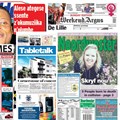The latest release of Inflation Watch - Q2 2018 - has been released. This study covers advertising rates and performance trends and an MIW Index, which is essentially a cost per thousand calculation. A summary of the findings shows that:
Television
All TV
Rates +7.41%
Performance -3.99%
MIW Index (CPM) +11.46%
Free-to-air TV
Rates +15.92%
Performance -1.44%
MIW Index (CPM) +16.85%
Pay-TV
Rates -10.62%
Performance -9.39%
MIW Index (CPM) +0.05%
Very different pictures continue for the two categories of TV. Although the average rates are +7.41% 2018 Jan-Jun on 2017 Jan-Jun, Free-to-Air's are +15.92% compared to Pay TV's -10.62%.
Examining Free-to-Air stations it becomes clear that SABC1 rates come in at +39.40% compared to SABC2 +15.20%, and the much smaller SABC3 -23.80%. e.tv has a modest rate increase of +3.30%. Overall the SABC's TV stations come in at +21.44% rate, with a TV group MIW Index (CPM) increase of +18.01%, reduced mainly by SABC1's performance increase of +10.0%.
Pay TV station's Jan-Jun 2018 rates are mostly down, some massively so, which linked to a mainly softening performance manages to get to a static MIW Index (CPM).
As noted in previous reports, free-to-air and pay-TV rate adjustments would seem to reflect a repositioning of linear TV relative to competing media platforms, and appears to be continuing to move in the changing TV landscape. Quite simply, the SABC need the cash, DStv Media Sales and others on its platform are repositioning themselves in the bigger world of video on demand. Plus, there is still the uncertain effects of the migration of the analogue TV signal to digital on free-to-air TV viewership.
Also, take a look at the calculated CPM's so as to get a more complete picture.
Print
All print
Rates +3.30%
Performance -7.29%
MIW Index (CPM) +12.76%
Dailies
Rates +2.34%
Performance -9.46%
MIW Index (CPM) +13.54%
Weeklies/Weekends
Rates +3.50%
Performance -9.18%
MIW Index (CPM) +15.54%
Communities
Rates +6.56%
Performance -1.01%
MIW Index (CPM) +7.76%
Consumer mags
Rates +1.94%
Performance -8.35%
MIW Index (CPM) +15.38%
BTB
Rates +3.19%
Performance +1.18%
MIW Index (CPM) +6.38%
Rate increases for the print medium, are at a historical low level and the rate of performance decline of (circulation) of many (but not all) of key dailies/weekends and consumer magazines does appear to be softer. That said a MIW Index (CPM) is still a double-digit +12.76%
So circulation, or lack of it, continues as the main driver, the real issue, in this sector. As stated previously, although there have been exceptions, it is the rare newspaper and magazine title that does not lose circulation.
Radio
All radio
Rates +9.17%
Performance -3.21%
MIW Index (CPM) +14.70%
Black format stations
Rates +14.98%
Performance -5.16%
MIW Index (CPM) +22.06%
CIW format stations
Rates +6.02%
Performance -2.15%
MIW Index (CPM) +10.70%
The overall rate increase for radio has moved to +9.17% Jan-Jun 2018 on Jan-Jun 2017, mainly due to black format stations (+14.98%) and within this sector mainly on SABC owned stations (+15.67%).
In addition, many stations appear to have lost audience, some significantly.
Accordingly, black format stations present MIW Index (CPM) increases substantially higher than CIW format stations, BUT as often noted black format stations have a calculated CPM considerably lower than CIW format stations. Thus there continues to be a small closing of the gap between the two.
In addition, CIW format radio stations display a CPM higher than the average pay-TV station and given the aggressive nature of DStv in this space the differential is likely to continue.
Technical note: In January 2016 the Broadcast Research Council’s new Rams study took over from Saarf’s Rams studies done previously, and the 2016 Jan-Dec BRC Rams listenerships ex-analyses by the stations are included in both Inflation Watch and the CPM Analysis for 2016. For 2017 the Jan-Jun, Apr-Sept and Jul-Dec releases of BRC Rams are used but opinion in radio circles is that the methodology did not properly consider the urban population sample sizes, affecting predominantly CIW format stations. Thus there may be some adjustments to future station rankings and you are urged to be careful when making performance comparisons.
Out of home
Rates +2.0%
Performance change none
MIW Index (CPM) +2.0%
Out of home again continues flat compared to competing media platforms, and certainly beneath the CPI. Availability continues at a high level. Having said that much depends on the contractor, format, advertiser demand and location. A good format unit in a prime position will be in demand and command a premium rate.
CPM viewpoints will shortly be included in CPM Analyses.
Cinema
Rates +0.0%
Performance +2.50%
MIW Index (CPM) -2.50%
The cinema Index is worked on the top 15 Ster-Kinekor houses (some 140 screens). Cinemark has had no real rate increase and audiences, as supplied by the company, indicate an increase of +2.50% Jan-Jun 2018 over the period of 2017. This results in a measured MIW Index (CPM) of -2.50%.
Online
Rates +7.40%
Performance 0.0%
MIW Index (CPM) +7.40%
Here a schedule of top sites reflects a calculated increase of +7.40% although in real market terms negotiations would negate most or all of this increase. Note there is no change in given performance because all the sites in the schedule have a CPM rate base: thus the performance measure is a constant.
Total all media
Rates +6.63%
Performance -4.13%
MIW Index (CPM) +11.69%
Rates at +6.63% overall Jan-Jun 2018 on Jan-Jun 2017 is higher than buyers have experienced in the last few years, mainly due to higher free-to-air TV and radio increases.
More problematic is the overall performance change of -4.13%, pushing the MIW (CPM) Index to +11.69%, the second highest first six-month number in the last 10 years. It means that unless advertising budgets increased by 11.69% or buyers negotiated even better this year compared to previous years, that exposure went backwards.
















































